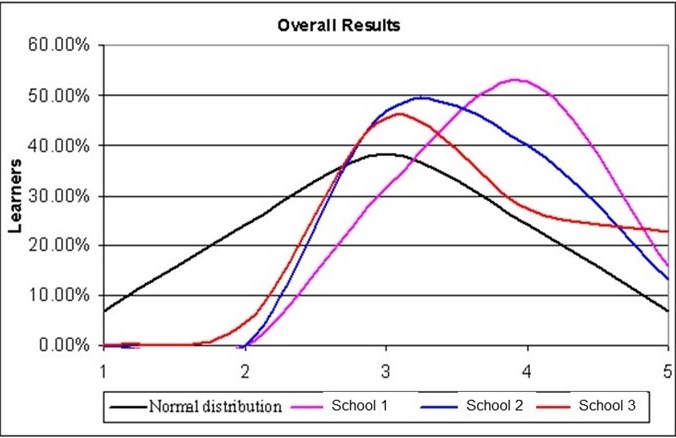
At School 1, a pre-school in Sandton, the children (a total of 22) had been exposed to Audiblox (the Schoolblox version) four times per week for 20 minutes at a time. The highest number of sessions that were attended was 320, the lowest 53, and the average 266.
At School 2, a pre-school in Pretoria, the children (a total of 15) had been exposed to Audiblox (the Schoolblox version) twice a week for 20 minutes at a time. The highest number of sessions that were attended was 320, the lowest 64, and the average 207.
At School 3, another pre-school in Pretoria, the children (a total of 19) had been exposed to Audiblox twice a week for 20 minutes at a time. The teacher at this pre-school had attended a five-day Audiblox training course. The highest number of sessions that were attended was 64, the lowest 24, and the average 56.
Aptitude test for school beginners
One of the tests done was the abbreviated battery of the Aptitude Test for School Beginners (ASB). The ASB was considered as the most important criterion to determine a child’s level of school readiness. It had been in use for many decades in South Africa and was widely applied in Grade 1, between the beginning of the eighth week and the end of the ninth week of the first school term, as the norms had been determined for this period. The battery was therefore applied four months earlier than usual.
The abbreviated battery of the ASB consists of the following three tests: Test 3 (Reasoning), Test 4 (Numerical) and Test 5 (Gestalt). Test 5 (Gestalt) measures the ability of a child to reproduce figures correctly. These three tests correlate strongly with the total score of the complete battery.
According to the test instructions every child should be tested in his/her mother tongue. At School 3 the children were tested in their mother tongue, which is Afrikaans. Five children (23% of the children) in School 1 and six children (40% of the children) in School 2 were English Second Language (ESL) children. These children were all tested in English, which is not ideal. Especially Test 4 (Numerical) requires mother tongue instruction. Testing them in English would therefore influence their performance in a negative sense.
Norm tables
The ASB test gives three norm tables:
- Norms for all South Africans
- Norms for non-environmentally (NED) disadvantaged children
- Norms for environmentally disadvantaged children
.
As the children in these pre-schools were considered “advantaged” they were compared to the norms provided for NED children.
According to the NED norm table 7% of non-environmentally disadvantaged children in South Africa score a stave of 1 (very weak), 24% score a stave of 2 (weak), 38% scored a stave of 3 (average), 24% score a stave of 4 (good), and 7% score a stave of 5 (good):
| Staves | Percentage of testees | Grading |
| 1 | Lowest 7% | Very weak |
| 2 | Next 24% | Weak |
| 3 | Middle 38% | Average |
| 4 | Next 24% | Good |
| 5 | Highest 7% | Very good |
.
Below is a graphic representation of the results obtained by each of the three pre-schools. To interpret the graph, they should be compared to the black line that indicates the normal distribution. For example, of the children in School 1,
0% scored a stave of 1 (very weak) compared to 7% of NED children;
0% scored a stave of 2 (weak) compared to 24% of NED children;
32% scored a stave of 3 (average) compared to 38% of NED children;
53% scored a stave of 4 (good) compared to 24% of NED children; and
16% scored a stave of 5 (very good) compared to 7% of NED children.






